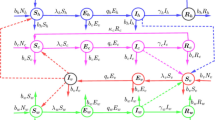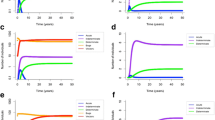Abstract
We present a mathematical model for the transmission of Trypanosoma brucei rhodesiense by tsetse vectors to a multi-host population. To control tsetse and T. b. rhodesiense, a proportion, ψ, of cattle (one of the hosts considered in the model) is taken to be kept on treatment with insecticides. Analytical expressions are obtained for the basic reproduction number, R 0n in the absence, and \(R_{0n}^{T}\) in the presence of insecticide-treated cattle (ITC). Stability analysis of the disease-free equilibrium was carried out for the case when there is one vertebrate host untreated with insecticide. By considering three vertebrate hosts (cattle, humans and wildlife) the sensitivity analysis was carried out on the basic reproduction number (\(R_{03}^{T}\)) in the absence and presence of ITC. The results show that \(R_{03}^{T}\) is more sensitive to changes in the tsetse mortality. The model is then used to study the control of tsetse and T. b. rhodesiense in humans through application insecticides to cattle either over the whole-body or to restricted areas of the body known to be favoured tsetse feeding sites. Numerical results show that while both ITC strategies result in decreases in tsetse density and in the incidence of T. b. rhodesiense in humans, the restricted application technique results in improved cost-effectiveness, providing a cheap, safe, environmentally friendly and farmer based strategy for the control of vectors and T. b. rhodesiense in humans.






Similar content being viewed by others
References
Aneth, M. M., Franklin, W. M., Johnson, M. M., & Eliningaya, J. K. (2007). Role of cattle treated with deltamethrine in areas with a high population of Anopheles arabiensis in Moshi, Northern Tanzania. Malar. J., 6, 109.
Artzrouni, M., Gouteux, J. (2001). A model of Gambian sleeping sickness with open vector populations. IMA J. Math. Appl. Med. Biol., 18, 99–117.
Anderson, N. E., Mubanga, J., Fevre, E. M., Picozzi, K., Eisler, M. C., Thomas, R., & Welburn, S. C. (2011). Characterisation of the wildlife reservoir community for human and animal trypanosomiasis in the Luangwa valley, Zambia. PLoS Negl. Trop. Dis., 5, e1211.
Bauer, B., Amsler-Delafosse, S., Kabore, I., & Kamuanga, M. (1999). Improvement of cattle productivity through rapid alleviation of African animal trypanosomiasis by integrated disease management practices in the agropastoral zone of Yale, Burkina Faso. Trop. Anim. Health Prod., 31, 89–102.
Bauer, B., Kabore, I., Liebisch, A., Meyer, F., & Petrich-Bauer, J. (1992). Simultaneous control of ticks and tsetse flies in Satiri, Burkina Faso, by the use of flumethrin pour-on for cattle. Ann. Trop. Med. Parasitol., 42, 41–46.
Bekele, J., Asmare, K., Abebe, G., Ayelet, G., & Gelaye, E. (2010). Evaluation of deltamethrin applications in the control of tsetse and trypanosomosis in the southern rift valley areas of Ethiopia. Vet. Parasitol., 168, 177–184.
Bourn, D., Grant, I., Shaw, A., & Torr, S. (2005). Cheap and safe tsetse control for live stock production and mixed farming in Africa. Asp. Appl. Biol., 75, 1–12.
Chitnis, N., Hyman, J. M., & Cushing, J. M. (2008). Determining important parameters in the spread of malaria through the sensitivity analysis of a mathematical model. Bull. Math. Biol., 70, 1272–1296.
Chizyuka, H. G. B., & Liguru, S. M. K. (1986). Dipping to control vectors of cattle parasites. Parasitology, 2, 123.
Coleman, P. G., & Welburn, S. C. (2004). Are fitness costs associated with resistance to human serum in Trypanosoma brucei rhodesiense? Trends Parasitol., 20, 311–315.
Davis, S., Aksoy, S., & Galvani, A. (2011). A global sensitivity analysis for African sleeping sickness. Parasitology, 138, 516–526.
Fèvre, E. M., Odiit, M., Coleman, P. G., Woolhouse, M. E. J., & Welburn, S. C. (2008). Estimating the burden of rhodesiense sleeping sickness during an outbreak in Serere, eastern Uganda. BMC Public Health, 8, 96.
Fox, R. G. R., Mmbando, S. O., Fox, M. S., & Wilson, A. (1993). Effect on herd health and productivity of controlling tsetse ad trypanosomiasis by applying deltamethrin to cattle. Trop. Anim. Health Prod., 25, 203–214.
Hargrove, J. W., Omolo, S., Msalilwa, J. S. I., & Fox, B. (2000). Insecticide-treated cattle for tsetse control: the power and the problems. Med. Vet. Entomol., 14, 123–130.
Hargrove, J. W., Torr, S. J., & Kindness, H. M. (2003). Insecticide-treated cattle against tsetse (Diptera: Glossinidae): what governs success? Bull. Entomol. Res., 93, 203–217.
Hargrove, J. W., Ouifki, R., Kajunguri, D., Vale, G. A., & Torr, S. J. (2012). Modeling the control of trypanosomiasis using trypanocides or insecticide-treated livestock. PLoS Negl. Trop. Dis., 6, e1615.
Magona, J. W., & Walubengo, J. (2011). Mass-treatment and insecticide-spraying of animal reservoirs for emergency control of Rhodesiense sleeping sickness in Uganda. J. Vector Borne Dis., 48, 105–108.
Mark, R., Naeem, D., Mike, K., Nasir, M., Hameed, U., & Sean, H. (2001). Control of malaria in Pakistan by applying deltamethrin insecticide to cattle: a community-randomised trial. Lancet, 357, 1837–1841.
Okello-Onen, J., Heinonen, R., Ssekitto, C. M. B., Mwayi, W. T., Kakaire, D., & Kabarema, M. (1994). Control of tsetse flies in Uganda by dipping cattle in deltamethrin. Trop. Anim. Health Prod., 26, 21–27.
Rogers, D. J. (1988). A general model for the African trypanosomiases. Parasitology, 97, 193–212.
Rowlands, G. J., Leak, S. G. A., Woudyalew, M., Nagda, S. M., Wilson, A., & d’Ieteren, G. D. M. (2000). Use of deltamethrin ‘pour-on’ insecticide for the control of cattle trypanosomosis in the presence of high tsetse invasion. Med. Vet. Entomol., 15, 87–96.
Shaw, A. P. M., Torr, S. J., Waiswa, C., Cecchi, G., Wint, G. R. W., Mattioli, R. C., & Robinson, T. P. (2013). Estimating the costs of tsetse control options: an example for Uganda. Prev. Vet. Med., 110, 290–303.
The Center for Food Security and Public health (2009). African animal trypanosomiasis. www.cfsph.iastate.edu.
Thomson, J. W., Mitchell, M., Rees, R. B., Shereni, W., Schoenfeld, A. H., & Wilson, A. (1991). Studies on the efficacy of deltamethrin applied to cattle for the control of tsetse flies (Glossina spp.) in southern Africa. Trop. Anim. Health Prod., 23, 221–226.
Torr, S. J., & Vale, G. A. (2011). Is the even distribution of insecticide-treated cattle essential for tsetse control? Modelling the impact of baits in heterogeneous environments. PLoS Negl. Trop. Dis., 5, e1360.
Torr, S. J., Maudlin, I., & Vale, G. A. (2007). Less is more: restricted application of insecticide to cattle to improve the cost and efficacy of tsetse control. Med. Vet. Entomol., 21, 53–64.
Torr, S. J., Wilson, P. J., Schofield, S., Mangwiro, T. N. C., & White, B. N. (2001). Application of DNA markers to identify the individual-specific hosts of tsetse feeding on cattle. Med. Vet. Entomol., 15, 78–86.
Uganda Bureau of Statistics (UBOS) (2008). National livestock census. http://www.ubos.org.
Van den Driessche, P., & Watmough, J. (2002). Reproduction numbers and sub-threshold endemic equilibria for compartmental models of disease transmission. Math. Biosci., 180, 29–48.
Vale, G. A., & Torr, S. J. (2005). User-friendly models of the costs and efficacy of tsetse control: application to sterilizing and insecticidal techniques. Med. Vet. Entomol., 19, 293–305.
Vale, G. A., Mutika, G., & Lovemore, D. F. (1999). Insecticide-treated cattle for controlling tsetse flies (Diptera: Glossinidae): some questions answered, many posed. Bull. Entomol. Res., 89, 569–578.
Waiswa, C., Picozzi, K., Katunguka-Rwakishaya, E., Olaho-Mukani, W., Musoke, R. A., & Welburn, S. C. (2006). Glossina fuscipes fuscipes in the trypanosomiasis endemic areas of south eastern Uganda: apparent density, trypanosome infection rates and host feeding preferences. Acta Trop., 99, 23–29.
Welburn, S. C., Coleman, P. G., Maudlin, I., Fèvre, E. M., Odiit, M. O., & Eisler, M. C. (2006). Crisis, what crisis? Control of Rhodesian sleeping sickness. Trends Parasitol., 22, 123–128.
WHO (2008). Uganda: country health profile. http://www.who.int/countries/uga/en/.
WHO (2011). The control of neglected zoonotic diseases. http://www.who.int/neglected_diseases/zoonoses/en/.
Zoller, T., Fèvre, E. M., Welburn, S. C., Odiit, M., & Coleman, P. G. (2008). Analysis of risk factors for T. brucei rhodesiense sleeping sickness within villages in south-east Uganda. BMC Infect. Dis., 8, 88.
Acknowledgements
This study was supported by the European Union’s Seventh Framework Program (FP7/2007–2013) under grant agreement No. 221948 Integrated Control of Neglected Zoonoses (ICONZ) (DK/JH, SCW); the United Kingdom Department for International Development Research into Use Programme (DFID-RIU) (PGC/JH/SCW) and by a European Science Foundation Senior Investigator(s) award Investigating Networks of Zoonosis Innovation INZI (SCW). We would like to thank all of the many research participants that were involved in this study, the numerous government officials and others who contributed.
Author information
Authors and Affiliations
Corresponding author
Appendix
Appendix
1.1 A.1 Derivation of the Tsetse Recruitment Rate, Λ V
The recruitment rate for the tsetse flies is based on newly emerged flies that are feeding for the first time (Hargrove et al. 2012; Rogers 1988; Welburn et al. 2006). These newly emerged flies have to survive death due to natural mortality and the effects of insecticides, and should not have fed for them to be susceptible to T. b. rhodesiense infection. Assuming a constant birth rate, B V , the number of newly born flies that survive and have not fed in one unit of time (that is, between t−1 and 1) is given by
Changing variables by letting u=t−s, Eq. (26) becomes
Changing variables again by letting x=ξ−t, Eq. (27) becomes
Equation (28) can be solved by using the the trapezium rule given by,
Using Eq. (29), the exponential part of Eq. (28) becomes
Substituting Eq. (30) into (28), we obtain
Again, using Eq. (29), (31) becomes
Taking n 1=n 2=2, Eq. (32) reduces to
Due to the delay terms in Eq. (32), cases where n 1=n 2>2 reduce to a Λ V that is complex to be solved with system (3) given in Sect. 2.
At the DFE, the proportion of cattle on insecticides is constant and given by \(\pi=\frac{\psi}{\psi+d+\mu_{1}}\). The solution for the tsetse recruitment rate at the DFE can thus be obtained by integrating Eq. (28) and is given by
Rights and permissions
About this article
Cite this article
Kajunguri, D., Hargrove, J.W., Ouifki, R. et al. Modelling the Use of Insecticide-Treated Cattle to Control Tsetse and Trypanosoma brucei rhodesiense in a Multi-host Population. Bull Math Biol 76, 673–696 (2014). https://doi.org/10.1007/s11538-014-9938-6
Received:
Accepted:
Published:
Issue Date:
DOI: https://doi.org/10.1007/s11538-014-9938-6




